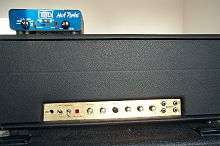Power attenuator (guitar)

In conjunction with an electric guitar amplifier, a power attenuator is used to divert and dissipate some or all of the amplifier's excess or unneeded power in order to reduce the volume of sound produced by the speaker.
Explanation
With tube guitar amplifiers, it is often desirable to produce distortion by overdriving the output stage. Under such a condition, the amplifier will produce at or near its maximum output power. The resulting volume level, however, may be considered unsuitable for many playing conditions. By reducing the amount of power delivered to the speaker, power attenuators reduce to desired levels the volume of sound produced by the amplifier, without altering the quality of the tone that is being sought.
The most common approach to power attenuation is the 'power soaker' approach. In a 'power soaker', a portion of the power is absorbed by the power attenuator (which is placed in circuit between the output transformer and the guitar speaker), while the remaining portion of the output power is directed to the speaker. An example of a common type of attenuator circuit is the L pad. A variable L pad is a power divider circuit that is designed to operate with a load in such a way as to provide an adjustable level of power to a speaker while maintaining a constant load impedance on the amplifier. [1]
A different approach, using a Variac or a power scaling circuit, reduces the B+ supply voltage available to the power tubes thus producing power tube distortion at a reduced level such that all available output power is sent to the guitar speaker. The Variac method is not without risk, as the reduced heater voltage applied to the tubes can damage the filament and/or cathode if not operated within the manufacturer's specifications. In a power scaling circuit, by decreasing just the B+ plate voltage, the cathode bias and screen grid voltage decrease proportionately, while the filament voltage stays constant. However the term power attenuator may be a misnomer for this type of power control because lowering B+ voltage tends to increase distortion, whereas according to convention, an attenuator should not introduce distortion.[2]
Power Damping is a method of output level control that involves the phase inverter and a potentiometer. The potentiometer allows that stage to be overdriven at reduced output similar to a Post Phase Inverter Master Volume (PPIMV) control.
Description
A power attenuator can be either purely resistive, or mostly resistive and partly reactive. The original guitar amp power attenuator, the Altair Attenuator, was primarily resistive, used a rotary switch to select taps on a toaster coil with low inductance windings. Another early model, simply called 'Power Attenuator' by Active Guitar Electronics, used continuously variable power rheostats. Other models, such as the Marshall Power Brake, add some electrical inductance or capacitance to the electrical load (including fans, light bulbs and coils). There is debate about whether reactive attenuators do a better job of preserving a guitar amplifier's tone.
A guitar amplifier power attenuator may also offer a line-level output jack for sending the distortion-processed signal through an effects chain, to a recording console, or for the purpose of re-amplifying signal through a larger or smaller amplifier.
If the amplifier is designed to accommodate being driven continuously at full power, the use of an attenuator will neither increase nor reduce the potential of damage to the amplifier. An early guitar amplifier to include a power attenuator was the Jim Kelley amplifier, which came with its own L-pad type attenuator. Some production attenuators are the Scholz Power Soak,[3] the Marshall Power Brake, THD Hot Plate, Weber MASS, and ARACOM.
See also
| Wikimedia Commons has media related to Power attenuator (guitar). |
- Power scaling
- Guitar amplifier
- Attenuator (electronics)
- Distortion (guitar)
- Isolation cabinet (guitar)
- Soundproofing
References
- ↑ Tremaine, Howard M. (1973). Audio Cyclopedia. Howard W. Sams & Co.
- ↑ Eastman, Austin (1949). Fundamentals of Vacuum Tubes. McGraw-Hill.
- ↑ "Rockman Story - SR&D". Retrieved April 14, 2010.